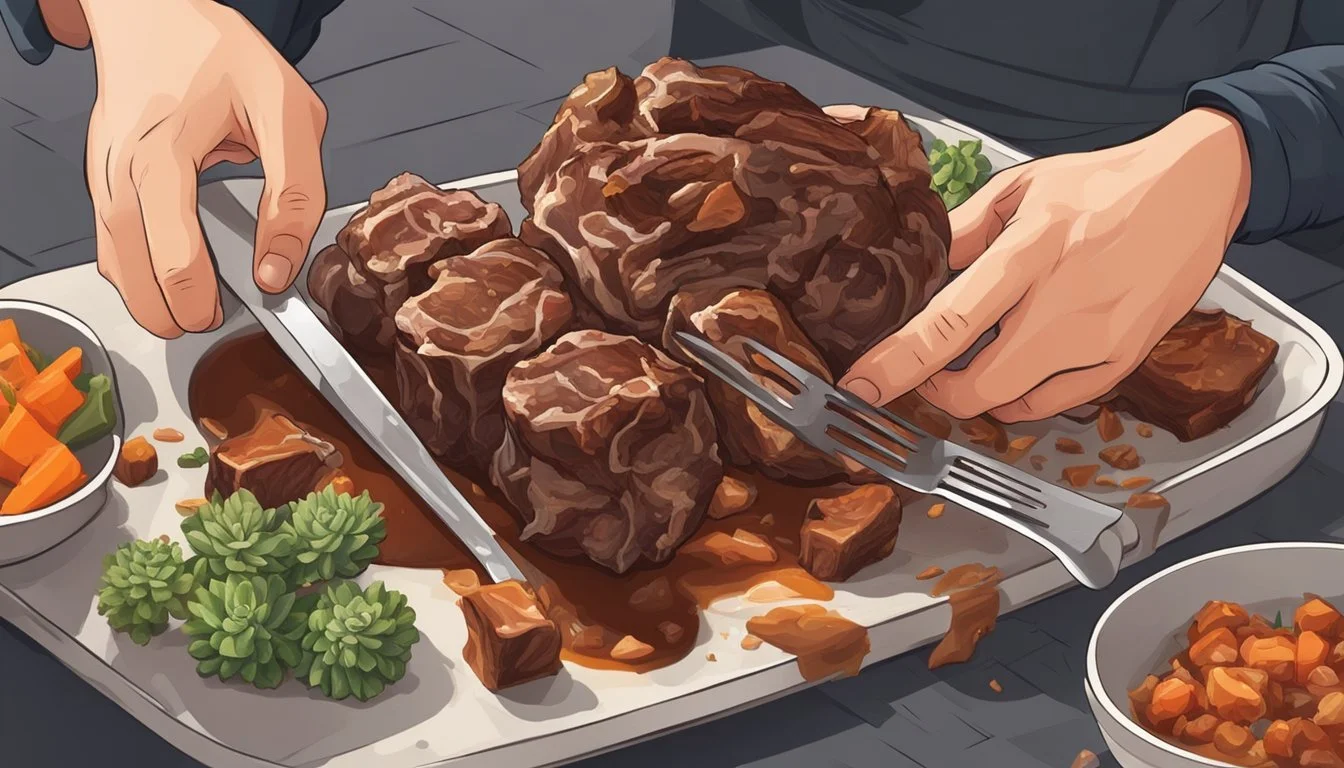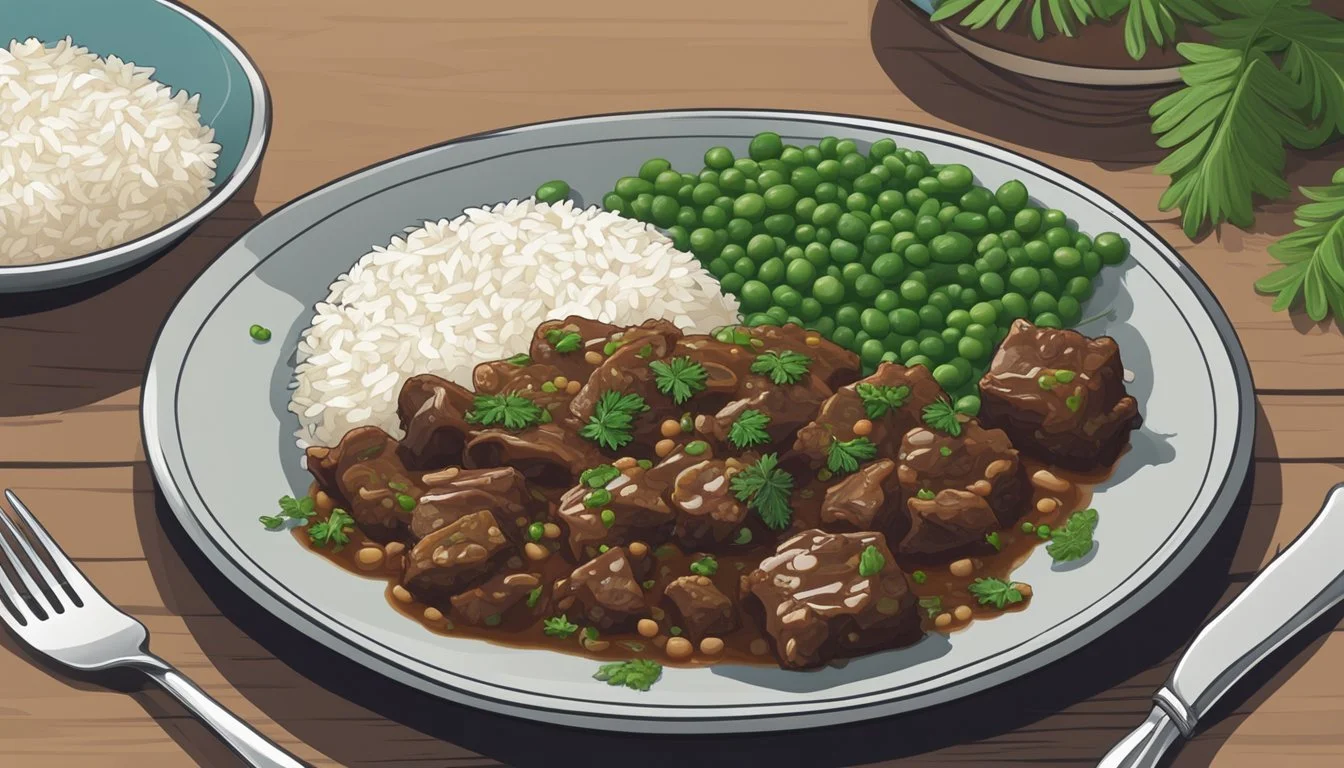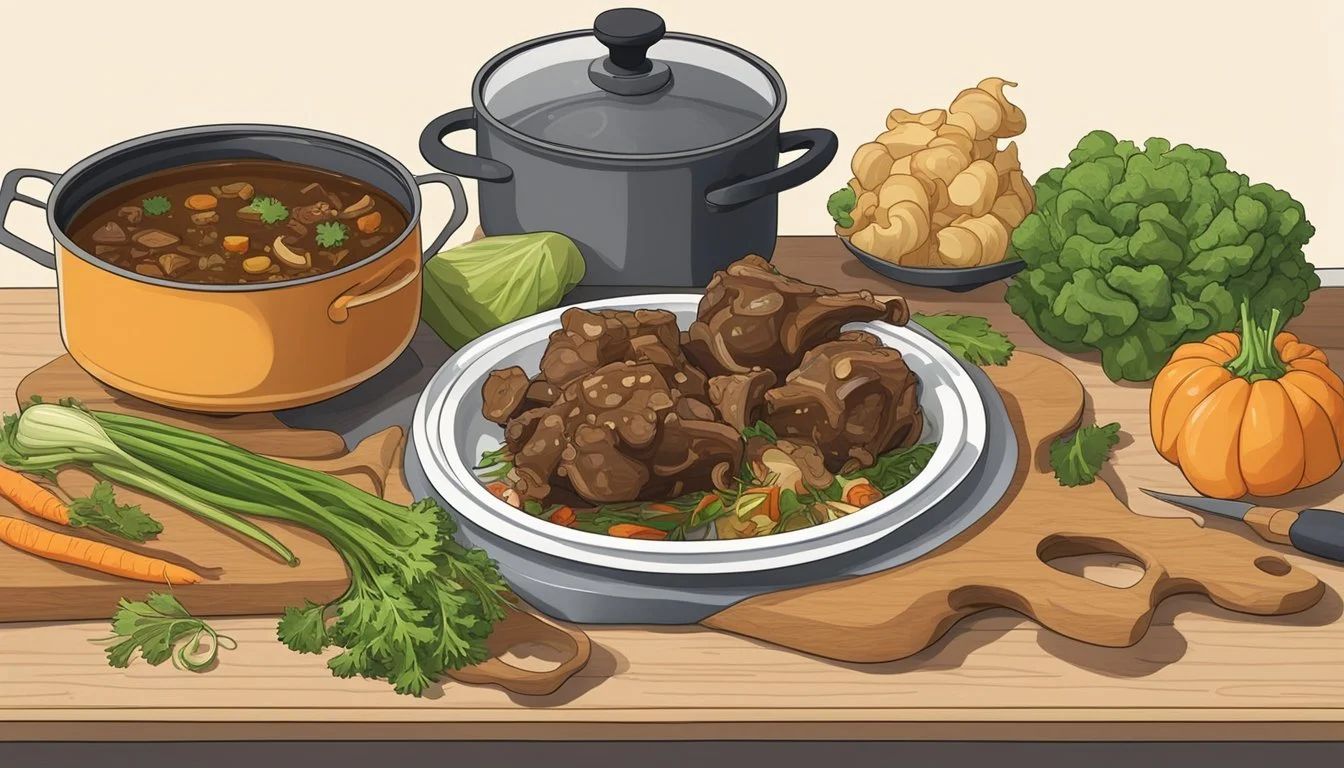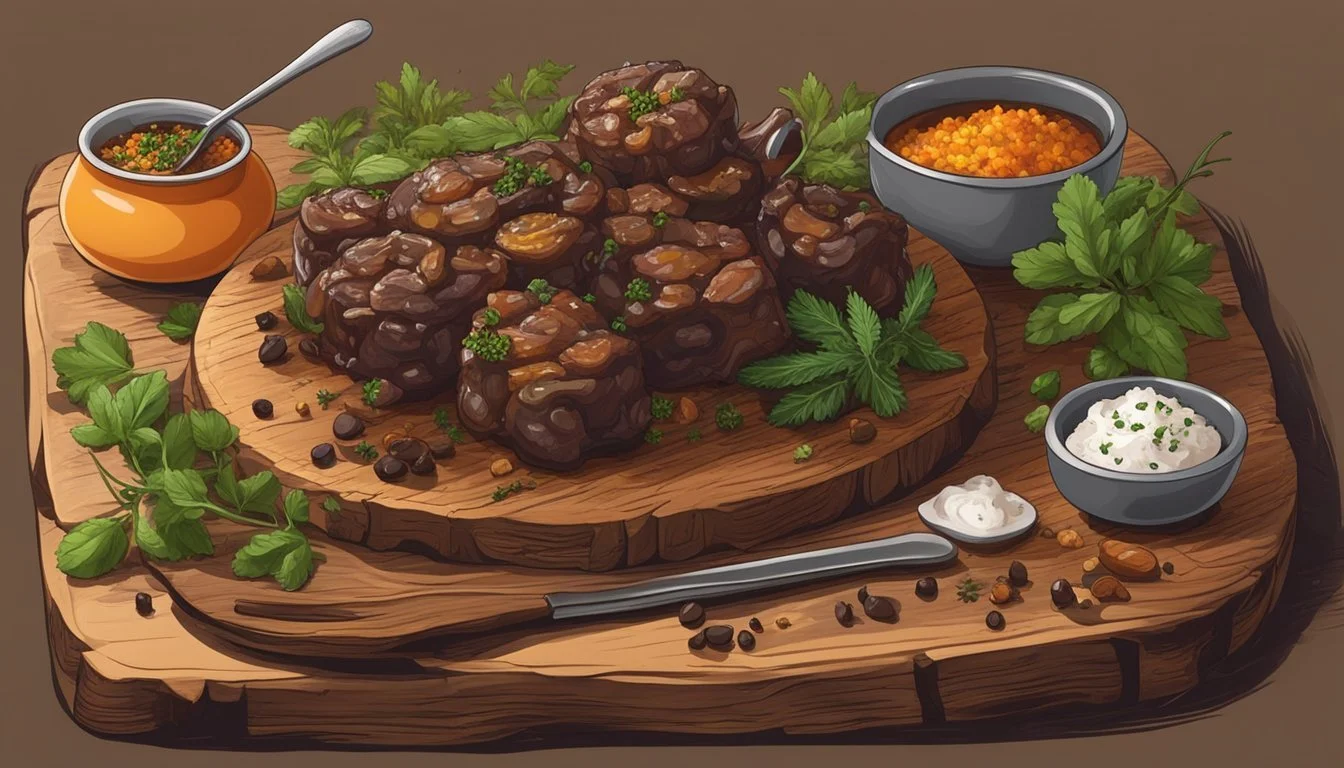How do you eat an oxtail?
Mastering the Art of Savoring This Delicacy
Oxtail refers to the tail of a cow and provides a rich flavor and gelatinous texture that is unmatched by other cuts of beef. Historically, the term originated when the tail came from oxen, but in modern cuisine, it encompasses tails from cattle of both genders. Its utilization reflects a nose-to-tail approach to cooking, where all parts of the animal are used, minimizing waste and maximizing variety in dishes.
Eating oxtail is an experience that involves slow-cooked preparations to tenderize the dense and fibrous meat. It's commonly cooked through braising or stewing, which allows the connective tissues to break down over several hours, creating a tender and flavorful result. The meat is often enjoyed in hearty soups, rich stews, and can also be served on its own, often garnished with fresh herbs (how long do fresh herbs last?) and accompanied by sides that complement its robust taste.
Oxtail has gained popularity across diverse cuisines, with Caribbean, African, Latin American, and European cultures all featuring it in traditional recipes. Cooks value oxtail for its depth of flavor, which enhances the overall savoriness of soups and sauces. It requires a lengthy cooking time, but the end result is a savory dish where the meat falls effortlessly off the bones, providing a rich and satisfying culinary experience.
History and Significance
Oxtail, historically regarded as a less desirable cut, has rich cultural ties and stands as a testament to resourceful culinary practices. It underscores the tradition of nose-to-tail eating, reflecting a deep respect for the animal by utilizing all parts.
Cultural Impact
Oxtail has a storied presence in various cuisines, notably within Caribbean communities and soul food traditions. It began as a cut of meat associated with poverty, often consumed by enslaved Africans who were given lesser cuts of beef cattle. Over time, it has become an integral component of family meals, celebrating shared heritage and nourishing connections across generations. In the Caribbean, particularly Jamaica, oxtail stew has evolved into a beloved dish prepared with a blend of spices, beans, and commonly served with rice.
Nose-to-Tail Eating Philosophy
The nose-to-tail eating philosophy advocates for using all parts of the animal. This ethos is both sustainable and economical, ensuring minimal waste in meat consumption. Cattle, including ox and cow, provide various cuts that are savored in different culinary contexts. Oxtail embodies this philosophy, with its rich, gelatinous texture transforming through slow cooking. Such a practice is not only a nod to tradition but also a conscientious choice in today's food culture.
Oxtail Characteristics
Oxtail refers to the tail of beef cattle and boasts a unique structure and composition that sets it apart as a culinary ingredient. It offers distinct culinary features due to its bone, marrow, and the surrounding meat which is rich in gelatin.
Distinctive Features
Oxtail meat surrounds the tailbones and is characterized by a high content of gelatin and connective tissue. This gives the meat a distinct texture that becomes tender and succulent when cooked slowly. Each section of oxtail contains a tailbone with marrow in the center, which during cooking releases fat, contributing to the meat's rich flavor and mouthfeel.
Nutritional Value
Nutrient Value per 100g (approx.) Calories 262 kcal Protein 25.6g Fat 17.2g Iron 3.6mg Zinc 4.5mg B Vitamins Varied amounts
Oxtail is not only substantial in flavor but also in its nutritional value, offering a good source of protein, essential B vitamins, iron, and zinc. The abundance of collagen turns into gelatin during the cooking process and is believed to have benefits for joint health. However, it's also relatively heavy in calories and fat, so portion control is advisable for those monitoring their intake.
Purchasing Oxtail
When looking for oxtail, consumers should consider the availability and price variables. Knowing where to find it and understanding its pricing can greatly affect the decision-making process.
Where to Find Oxtail
Supermarkets and specialty butchers often carry oxtail. Consumers can normally find it in the meat section, where it may be sold fresh or frozen. The supply of oxtail can be limited, as it is a single cut from the animal's tail and each animal provides a small amount. This scarcity can sometimes make it more of an occasional find, especially in smaller markets. In larger urban areas with diverse populations, ethnic markets could be ideal locations to purchase oxtail due to a higher demand for varied cuts of meat.
Price Considerations
The price of oxtail can be expensive relative to more common cuts of beef due to the laws of supply and demand. Prices can vary based on several factors:
Location: Urban supermarkets or butchers might charge more due to higher cost of operation.
Quality: Organic or grass-fed beef oxtail commands a premium.
Seasonality: Prices can fluctuate based on the time of year and availability.
Consumers should be prepared to pay a higher cost per pound for oxtail compared to more abundant cuts. The precise pricing at any given time can best be determined by checking with local suppliers or comparing costs across different vendors.
Preparation Basics
Eating an oxtail requires understanding its preparation which involves specific equipment and some initial steps. Proper preparation enhances the dining experience by unlocking the rich flavors inherent in the meat.
Essential Equipment
To prepare oxtail, one needs sturdy kitchen tools due to the tough nature of the meat. Below are the recommended instruments:
Slow Cooker: Ideal for tenderizing oxtail over several hours. Oxtails require extended cooking times, and a slow cooker offers the perfect low-heat, consistent cooking environment.
Pressure Cooker: An alternative for faster cooking, a pressure cooker can reduce the cooking time significantly while still rendering the meat tender.
Sharp Knife: Necessary for initial preparation such as trimming fat if needed.
Cutting Board: Provides a safe and clean surface for meat handling.
Skillet: For browning the meat, which is a critical step in flavor development.
Initial Preparation
The initial preparation involves a few critical steps to ensure the oxtail is ready for the cooking process:
Refrigeration: If not using immediately, store oxtail in the refrigerator to maintain freshness. Place it in an airtight container or wrap it tightly in plastic wrap or aluminum foil.
Rinsing and Patting Dry: It's important to thoroughly rinse the oxtail under cold water and pat it dry with paper towels. This step is crucial to remove any bone fragments or residue.
By incorporating these equipment and preparation steps, one sets the stage for a successful oxtail dish that is flavorful and tender.
Cooking Techniques
Cooking oxtail properly is imperative to achieve the dish's signature tender texture. Two renowned techniques favored for their ability to break down the tough fibers of the tail are braising and slow cooking. These methods help to extract the richness from the oxtail, rendering the fat, and allowing the flavors to concentrate in the resulting broth or sauce.
Braising Oxtail
To braise oxtail, one first sears the pieces until brown to develop flavor. The oxtail is then cooked in a small amount of liquid, typically a combination of stock and robust seasonings, in a covered pot at a low temperature. This long and gentle cooking process allows the oxtail to become exceptionally tender. Braising is ideal for creating a rich sauce or gravy to complement the dish, most often served with root vegetables or as an enhancement to a hearty stew.
Slow Cooking Oxtail
Slow cooking, in contrast, involves cooking the oxtail at low heat for an extended period, typically in a slow cooker or a low oven. The low heat allows the fatty meat to soften gradually while maintaining a moist environment. In this method, the oxtail is often combined with ingredients such as herbs, spices, and vegetables, which melds over time into a flavorful broth or bone broth. A key advantage of slow cooking is that it is less hands-on yet still yields a slow-cooked oxtail that can be used in various recipes, including soups and flavorful oxtail stews (What wine goes well with stews?).
Classic Oxtail Recipes
Oxtail is a versatile meat that lends itself to a variety of rich and hearty dishes worldwide. From stews to soups, it's often cooked slowly to tender perfection, accompanied by a colorful array of vegetables and an array of international flavors.
Oxtail Stew Variations
The traditional Oxtail Stew is a beloved dish that showcases the meat's depth of flavor when combined with a robust blend of ingredients. Typically, an oxtail stew includes:
Vegetables: Onions, leeks, carrots, and celery are sautéed to create a flavorful foundation.
Liquid: Beef broth is commonly used to simmer the oxtail pieces, along with the stewing vegetables.
Seasonings: Varied seasonings such as bay leaves, Worcestershire sauce, and tomato paste add layers of flavor.
Thickeners: Flour or a roux can be incorporated to achieve the stew’s characteristic thick consistency.
In a stew, the oxtail is often browned first, then slow-cooked with vegetables like parsnips and potatoes until the meat falls off the bone. Many variations include additional components like bell pepper or other regional vegetables, and the liquid in which the oxtail is cooked can range from a simple stock to a combination of stock and red wine or even a tomato-based sauce.
Global Cuisines
Oxtail takes center stage in various global dishes, reflecting the local flavors and cooking techniques.
Jamaican Oxtail Stew: A spicy and savory stew known for its use of allspice, thyme, and scotch bonnet peppers, served with beans and rice, highlighting the fusion of flavors that define Caribbean cuisine.
Spanish Cuisine: In Spain, oxtail may be prepared as part of a hearty stew known as "Rabo de Toro," commonly cooked with regional Spanish wines, creating a rich and aromatic sauce.
Eastern European Soups: Eastern Europe has a variety of oxtail soups, often featuring root vegetables and served with mashed potatoes or rice, exemplifying the hearty comfort food of the region.
Oxtail dishes are often paired with rice or starchy vegetables like potatoes to provide a comforting meal. Whether incorporated into a luscious Caribbean stew served with rice and beans, or a velvety Eastern European soup accompanied by mashed potatoes or polenta, oxtail recipes offer a satisfying and multifaceted eating experience.
Serving Recommendations
When serving oxtail, one's aim should be to complement the rich and beefy flavor that becomes pronounced upon proper cooking. The texture, if cooked slowly, often results in fall-off-the-bone tenderness. This section will provide specific ideas for accompaniments and presentation tips to best enjoy oxtail's unique taste and texture.
Accompaniments
The robust flavor of oxtail pairs well with a variety of side dishes. The goal is to balance the hearty taste without overpowering it. Here's a selection of sides that complement oxtails:
Starchy Sides:
Garlic Rolls: They absorb the sauce and add a soft textural component.
Polenta: It provides a creamy base that contrasts the beefy flavor.
Buttered Noodles: A simple option that doesn't compete with the main course's flavors.
Vegetables:
Steamed Broccoli with Lemon Butter: Offers a fresh counterbalance to the oxtail's richness.
Green Beans with Garlic: A side that introduces a crisp texture and aromatic twist.
Rice and Legumes:
Sultana Rice: Adds a subtle sweetness that complements the savoriness.
Boereboontjies (South African Beans): These bring in a cultural element and are traditionally served with oxtail.
Presentation Tips
The presentation of oxtail should highlight its succulence and depth of flavor:
Plating: Serve oxtail on a warm plate to maintain its temperature. Place the oxtail centrally and spoon over some of the cooking liquid to showcase its sauciness.
Garnishes:
Fresh Herbs: A garnish of fresh parsley or thyme can add color and a hint of freshness.
Lemon Zest: A small sprinkle over the top can cut through the richness and enhance the natural flavors.
Storage and Leftovers
When it comes to oxtail, proper storage is essential to maintain its quality and ensure food safety. Oxtail leftovers can be effectively stored in the refrigerator or freezer, and there are specific techniques for reheating to retain the dish's delicious flavor and texture.
Refrigeration and Freezing
Refrigeration: Cooked oxtail should be refrigerated within two hours of cooking to prevent bacterial growth. It should be placed in an airtight container and can be safely stored in the refrigerator for 3-4 days.
Container: Airtight container
Refrigeration Time: 3-4 days
Freezing: For longer storage, cooked oxtail can be frozen. To freeze oxtail:
Allow it to cool completely.
Transfer it to a freezer-safe container or zip-top bag, removing as much air as possible.
Label it with the date to keep track of how long it's been stored.
Store in the freezer at 0°F (-18°C).
Cooked oxtail can remain in the freezer indefinitely in terms of safety, but for best quality, consume within 1-3 months to prevent the meat from drying out and losing flavor.
Cooling Time: Until room temperature
Freezer-Safe Container: Yes
Labeling: With the date
Freezer Time for Best Quality: 1-3 months
Reheating Instructions
When reheating oxtail, one should aim for even warming without drying out the meat. Here are the steps:
Remove the oxtail from the refrigerator or freezer and let it come to near room temperature for more even reheating.
For the refrigerator leftovers, reheat in a covered skillet or saucepan on the stove over medium-low heat, stirring occasionally until heated through.
For frozen oxtail, thaw it in the refrigerator overnight before reheating.
If using an oven, place the oxtail in an oven-safe dish, cover it with foil, and warm it at 350°F (175°C) until heated through, which typically takes about 20-30 minutes.
Heating times may vary depending on the amount of oxtail and the reheating method used. It's important not to rush reheating to avoid toughening the meat.
Health and Diet Considerations
When incorporating oxtail into one's diet, it is important to consider both the health benefits and the dietary inclusions that it offers. Known for its protein content and the presence of beneficial compounds such as collagen, oxtail can be a valuable addition to various dietary regimens, including carnivore, paleo, and ketogenic diets.
Dietary Inclusions
Oxtail, rich in protein and collagen, makes it a suitable meat choice for those following carnivore, paleo, or ketogenic diets. These diets emphasize the consumption of animal products and low-carb, high-fat foods, making oxtail an appropriate fit.
Carnivore Diet: Oxtail is purely animal-based, aligning with the carnivore diet's emphasis on meat and avoiding plant-based foods.
Paleo Diet: It adheres to the principle of whole, unprocessed foods mirroring ancient human diets, and oxtail is a natural, minimally processed food item.
Ketogenic Diet: With its high fat content, oxtail can be quite ketogenic-friendly, although one must account for the protein levels to maintain ketosis.
Health Benefits
The consumption of oxtail provides specific health benefits attributed to its nutrient profile. The gelatin and collagen found in oxtail are essential for skin and hair health, potentially aiding in increasing skin elasticity and the strength of nails and hair.
Collagen: A vital protein that promotes skin and joint health.
Protein: Necessary for muscle maintenance and overall bodily functions.
Gelatin: Derived from collagen, often used in foods and can support digestive health.
In summary, oxtail can be a nutritious addition to various diets, particularly those emphasizing high protein and fat intake. The presence of collagen and gelatin also offers additional health benefits that may appeal to individuals focused on maintaining and improving skin and hair health.
Alternative Uses and Substitutions
When traditional oxtail is unavailable, various other cuts of beef can offer a comparable depth of flavor and texture. Knowing which substitutes to use can ensure the integrity of the dishes that traditionally incorporate oxtail.
Oxtail Equivalents
Beef Tendon: Richer than oxtail, beef tendon can mimic the gelatinous quality that oxtail provides, especially in soups and stews.
Beef Neck: While tougher than oxtail, beef neck has enough fat and connective tissues to enrich dishes, requiring a longer simmer to become tender.
Beef Shank: As an oxtail substitute, beef shank delivers a similar texture and is best cooked slowly to break down the muscle fibers it contains.
Short Ribs: They are meatier and have bones that can provide gelatin and marrow, leading to a comparable mouthfeel and richness.
Substitute Qualities Best Use Case Beef Tendon Gelatinous, rich flavor Long simmering in soups and stews Beef Neck Fatty, tough texture Slow cooking to soften Beef Shank Hard texture, requires long cooking Slow braises or stews Short Ribs Meaty, fatty, contains marrow Braising to achieve tenderness
Creative Cuisine
Bone Marrow: As an alternative, the marrow found in bones like shank or short ribs can be used to infuse dishes with a rich, umami flavor not unlike that found in oxtails.
Veal: For those seeking a lighter option, veal can serve as a delicate substitute with a meaty profile that absorbs flavors well, especially in preparations that originally call for oxtail.
By understanding these alternatives, one can adapt recipes to include similar textures and flavors, preserving the essence of the dish without oxtail.
Conclusion
Oxtail, the culinary term for the tail of beef cattle, offers a distinctive dining experience for those seeking to explore its rich flavors and versatile use. This cut has transitioned from a traditional, economical option to a beloved ingredient in various cuisines due to its robust taste and tender texture post-cooking. Not simply reserved for soups, the meat lends itself well to an array of preparations, from stews and braises to modern fusion dishes.
Availability has increased as oxtail’s popularity has grown, making it more accessible at local butchers and supermarkets alike. Its versatility in the kitchen becomes evident when paired with various spices and ingredients that complement its natural flavor profile. Chefs and home cooks alike appreciate oxtail for its ability to absorb and enhance the spices and herbs it’s cooked with.
Oxtail's gelatinous content guarantees a velvety mouthfeel, particularly in slow-cooked meals, allowing it to shine as both a main course and a component in complex, flavor-built dishes. Whether incorporated in traditional recipes or innovative culinary experiments, the flavorful meat confidently asserts its place at the table.
Enthusiasts will find that oxtail’s adaptability extends to a myriad of global flavors, affirming its status within the culinary world. Individual creativity and local ingredients can transform the humble tail piece into a showcase of cultural delight, ensuring that recipes featuring oxtail remain evolving and dynamic reflections of both personal taste and historical significance.
Glossary
Oxtails: The posterior extension of the animal's backbone, harvested from beef cattle. In culinary use, it refers to the tail of the cow, portioned into sections and prepared for cooking.
Collagen: A protein found abundantly in oxtails. When cooked slowly, collagen breaks down into gelatin, giving oxtail dishes their signature rich, silky texture.
Gelatin: The substance formed when collagen breaks down during the cooking process. It thickens broths and sauces, adding a luscious mouthfeel to the dishes incorporating oxtails.
Marrow: A nutrient-rich substance found inside the bones, including the segments of an oxtail. Marrow contributes depth of flavor and is highly regarded for its culinary properties.
Fat: Found in pockets around the oxtail, fat renders into the dish while cooking, providing flavor and enhancing the texture of the final dish.
Connective Tissue: Surrounds the muscle fibers in the tail. It requires prolonged cooking to tenderize, which is why slow cooking methods, like braising or stewing, are commonly used for oxtail.
Tailbone: The series of small vertebrae running through the center of the oxtail. When cooked, the meat surrounding the tailbone becomes tender and can be easily removed.
Bones: The central part of the oxtail which contributes to the body of broths and soups due to its minerals and collagen content.
This glossary section covers key terms related to the topic of eating an oxtail, offering clear definitions to enhance understanding of the various components and characteristics of this culinary delicacy.
References
When discussing how to eat an oxtail, the sources below provide culinary insights and cooking techniques that are pertinent to the proper preparation and enjoyment of this meat cut.
The Spruce Eats An article titled "What Is Oxtail?" covers the history and current use of oxtail, a cut of beef or veal from the tail of the cattle.
Mashed The piece "What Is Oxtail And How Do You Cook It?" explains the richness of oxtail due to the bone marrow, influencing both the cooking methods and flavor profile.
Browsey Acres In "Wagyu Oxtail: What Is It & How Do You Eat It?" the focus is on preparation techniques, emphasizing slow cooking to dissolve connective tissues for optimal flavor.
The Kitchn The Kitchn offers an overview in their article “Oxtail: What It Is, And What To Do With It,” detailing how oxtail should be prepared for stocks, soups, and braises.
Using these references, one can gather that oxtail should be cooked slowly, often braised or stewed, to ensure the tough connective tissue becomes tender. The bone marrow adds a rich depth to dishes, and while the preparation takes time, the results are well-regarded for their flavor and texture.









